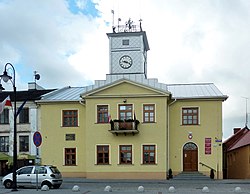Lipno, Lipno County
Lipno | ||
|---|---|---|
 Town hall | ||
|
Car plates CLI | | |
| Website | http://www.umlipno.pl/ | |
Lipno (Polish pronunciation:
The town is the birthplace of actress Pola Negri, economist Leszek Balcerowicz and politician Ya'akov Meridor.
History
Lipno dates back to the
The town was annexed by Prussia in the Second Partition of Poland in 1793, in 1807 it became part of the short-lived Polish Duchy of Warsaw and in 1815 it became part of so-called Congress Poland in the Russian Partition. Many inhabitants took part in the unsuccessful November and January Uprisings against Russia, after which Lipno was subject to severe persecutions.[1] Nevertheless, local Poles founded various organisations.[1] Lipno became part of independent Poland again, when the country proclaimed independence on 11 November 1918, afterwards the town's cultural life was revived.[1]

During the Polish–Soviet War, the town was briefly occupied by the Soviets from 13–14 August 1920.[1][2] The Soviets then plundered private homes and shops, as well as the municipal office, and terrorized the population.[3] Prominent local activist and organizer of the Polish defense, Jerzy Starzyński, was subjected to gruesome tortures and murdered.[4] Nearly half of the occupying security forces were local communist Jews, recruited mainly from the poor.[5] Wealthy Jews and Orthodox Jews did not support the Soviets, and several wealthy Jews were robbed and murdered by the Soviets.[5] Lipno was liberated by Poles on 20 August 1920.[6] A monument to local Polish soldiers fallen in the war was erected in 1930.[7]
In 1924, Zygmunt Uzarowicz, a former Polish independence activist in the Russian Partition of Poland, became the mayor of the town, and held office until the German invasion of Poland in 1939.[8]
During the
Sports
The local football team is Mień Lipno, which competes in the lower leagues.
Gallery
-
Church of the Assumption
-
Post office
-
Memorial at the site of a public execution of 10 Poles by the Germans in 1940
-
World War II memorial
-
Memorial plaque to pre-war mayor Zygmunt Uzarowicz
-
District court
References
- ^ a b c d e f g h i j k l "Historia". Urząd Miejski w Lipnie (in Polish). Retrieved 10 May 2020.
- ^ Mirosław Krajewski, Ziemia dobrzyńska w cieniu Czerwonej Gwiazdy. Rok 1920, Wszechnica Edukacyjna i Wydawnicza Verbum, Rypin, 2010, p. 27 (in Polish)
- ^ Krajewski, p. 28
- ^ Krajewski, p. 30
- ^ a b Krajewski, p. 115
- ^ Krajewski, p. 57
- ^ Krajewski, p. 121
- ^ a b "Zygmunt Uzarowicz". Urząd Miejski w Lipnie (in Polish). Retrieved 12 June 2020.
- ^ Maria Wardzyńska, Był rok 1939. Operacja niemieckiej policji bezpieczeństwa w Polsce. Intelligenzaktion, IPN, Warszawa, 2009, p. 111 (in Polish)
- ^ Wardzyńska, p. 171, 175-176
- ^ Wardzyńska, p. 175-177
- ^ Wardzyńska, p. 175
- ^ a b Krajewski, p. 122








